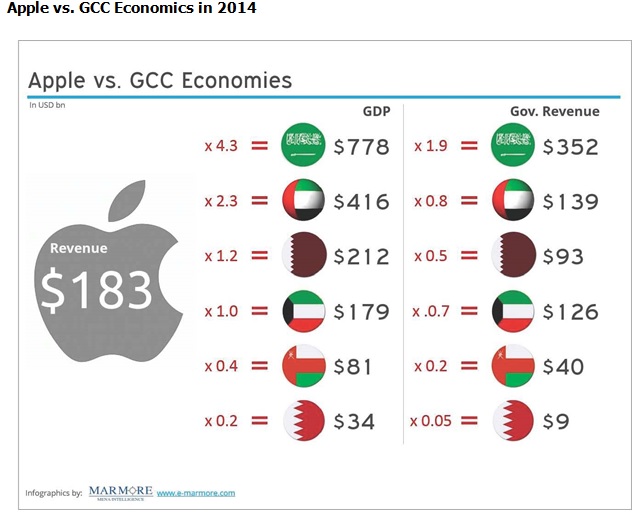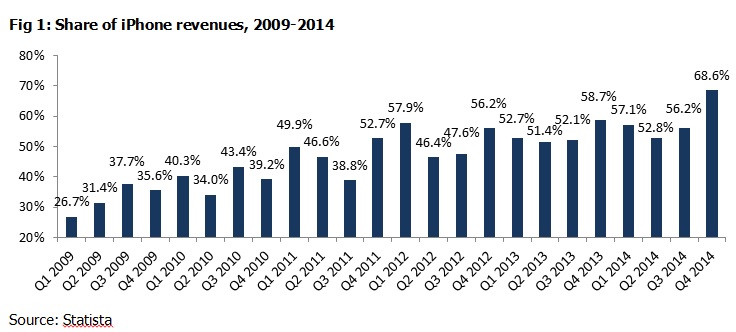_36.jpg)
Kuwait Financial Centre “Markaz” recently released a note on investing in Apple. In this report, Markaz examines Apple’s business model, its sustainability, and concludes with a discussion on whether Apple is a suitable investment for GCC institutional investors and HNIs.
The release of Apple iPhone 6 and iPhone 6 Plus in September 2014 led to strong sales in both developed and emerging markets. According to Apple CEO, Tim Cook, 34,000 iPhones were bought every hour of every day during the last quarter of 2014, prompting several comparisons by various analysts. One pointed out that Apple had made more profit in the last quarter of 2014 than what 435 firms in the S&P 500 had made individually since 2009, while another stated that the company’s iPhone sales last quarter was worth more than the sales of Google and Microsoft combined. What makes this recent success even more astounding is the fact that Apple has taken the lead in the Chinese smartphone market for the first time in terms of number of units shipped.
Apple’s cash reserves alone are worth USD 178billion, which is larger compared to any other corporation in the world, and is more than the market cap of over 480 companies listed in the S&P 500. It also exceeds the respective GDPs of countries such as Kuwait, Morocco, Oman, Syria, Libya, Lebanon, and Bahrain.
The company’s business strategy hinges on its ability to design and develop its own operating systems, hardware, application software and services. Rob Chira, Senior Managing Director and Technology Analyst at Evercore, says that Apple’s phenomenal success relied on its ability to own both the hardware and the platform. While everyone gave up on that business model, Apple proved that if you get it right, the upside leverage is huge.
Apple has invested in own retail and online stores, and has a third-party distribution network to effectively reach more customers and provide them sales and support experience. Its revenues are dominated by sale of iPhones, which has contributed over 50% in the past few years and currently stands at a staggering 69%. With the introduction of the latest series of iPhones, the number of iPhone units sold rocketed from 39.3million in Q3 2014 to 74.5million in Q4 2014, a rise of 90%. Revenues from the iPhone rose 116%, from USD 23.7billion to USD 51.2billion, during the period.
So how’s Apple making all this money, when over 50% of its sales are driven by a single product? The answer lies in the margin. The store value of an iPhone 6 ($649) or an iPhone 6 Plus ($749) is over 3.2x and 3.5x, respectively, of the cost of their individual components and the labour that goes into making them.Analysts wonder how long this revenue model be sustained, as in the US and Western Europe close to 70% of cell phone users own a smartphone, and according to Colin Gills, Analyst at BGC partners, growth in smartphone sales will likely be at the 5% to 10% range. In the tablet segment, Apple’s market share has come down to 23% in 2014, from 29% in 2013. The next rung of products comes with their own challenges. Smartwatches haven’t taken off in a big way, and the global adaptability of Apple Pay remains uncertain.
While increasing reliance on one product line is a cause for concern, the company has recently witnessed a surge in sales emerging markets, and there is scope for growth in the other global smartphone markets. But consumers today have a wide range of smartphones to choose from, including BlackBerry, Android smartphones from Samsung, LG, and low cost manufacturers like Lenovo, Micromax and Xiaomi, and while the smartphone market is forecasted to grow in double digits, most of the growth would be towards the low- and mid-priced products, unlike the iPhone, which caters to the increasingly saturated high-end market.
But Apple’s ability to integrate its services across various platforms and devices continues to drive the company, and trump industry peers in the market.
Apple’s competitive edge lies in its perceived quality, which aids its entry into new market segments (TV, smartphone, smart watch, payment systems). Apple products still command a premium that ensures its profits stay well ahead of competitors, who are mostly involved in volume business. The company’s strength lies in selling premium hardware at high margins to the high-end smartphone market, and supports the product with vertical integration with other Apple products (Mac, iPad etc.) and by selling content (App Store, iTunes etc.). Many believe that Apple’s success lies in the ecosystem that it has created among its many offerings. While announcing the latest series of iPhone, Apple’s CEO Tim Cook indicated that the product isn’t a standalone collection of features, but how it all works together provides the Apple experience.
The future direction of the firm will rely on the successful adaptability of Apple Pay, and other platforms (TV, Car etc.) that can potentially be inducted into the Apple ecosystem. In the near- to medium-term, Apple will continue to generate value, and will seek to leverage on the goodwill of its brand. Either as a stock or as part of mutual fund, Apple seems a good idea from a historical context, or when measured from analysts’ recommendations. As Toni Sacconaghi from Bernstein Research puts it… “There is still more room on this ride!”


About Kuwait Financial Centre “Markaz”
Kuwait Financial Centre K.P.S.C “Markaz”, with total assets under management of over KD 1.089 billion as of December 31, 2014, was established in 1974 has become one of the leading asset management and investment banking institutions in the Arabian Gulf Region. Markaz was listed on the Kuwait Stock Exchange (KSE) in 1997.
For further information, please contact:
Senior Officer
Media & Communications Department
Kuwait Financial Centre K.P.S.C "Markaz"
Tel: +965 2224 8000 ext 1819
Dir: +965 2224 8075
Fax: +965 2241 4499
Email: [email protected]
www.markaz.com

